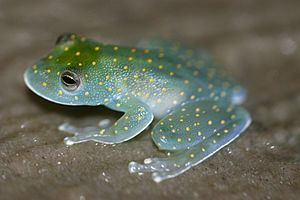Cochranella euknemos facts for kids
Cochranella euknemos, also known as the San Jose Cochran frog, is a small type of frog. It belongs to the family Centrolenidae, which are often called glass frogs because some of them have see-through skin!
You can find this frog in central Costa Rica, and moving south and east into Panama. It also lives in western Colombia, in areas like Antioquia and Chocó Department.
Quick facts for kids Cochranella euknemos |
|
|---|---|
 |
|
| Conservation status | |
| Scientific classification | |
| Synonyms | |
|
Centrolenella euknemos Savage and Starrett, 1967 |
Contents
What Does This Frog Look Like?
Cochranella euknemos are tiny frogs. Male frogs grow to about 25 millimeters (1 inch) long from their nose to their rear. Female frogs are a bit bigger, reaching about 32 millimeters (1.25 inches).
Their back is blue-green and feels a little bumpy. They have many small whitish or yellowish spots. Their belly is clear white, but the undersides of their arms and legs are more yellow. Their eyes are a grayish ivory color. Their feet have some webbing between the toes, which helps them swim.
How Do They Reproduce?
In Costa Rica, male frogs make calls from May to November. These calls are how they attract females. The female frogs lay their eggs in a jelly-like mass. They place these egg masses on the tips of leaves that hang over streams. When the tadpoles hatch, they will drop into the water below.
Where Do These Frogs Live and Are They Safe?
These frogs live in wet forests. You can find them in forests that are low to the ground, or in forests higher up in the mountains. They like to stay in bushes and trees near streams that are covered by forest. In Colombia, they live at heights from 100 to 1,940 meters (about 330 to 6,360 feet) above sea level.
Sadly, Cochranella euknemos faces some dangers. In Panama, their homes are threatened by deforestation, which means forests are being cut down. East of the Panama Canal, they are also threatened by a serious frog disease called chytridiomycosis.
In Costa Rica, the number of these frogs has gone down. They haven't been seen there since 1986, even though people have looked for them. Scientists are still trying to figure out why they have disappeared from that area.
Want to Learn More?
 In Spanish: Cochranella euknemos para niños
In Spanish: Cochranella euknemos para niños


